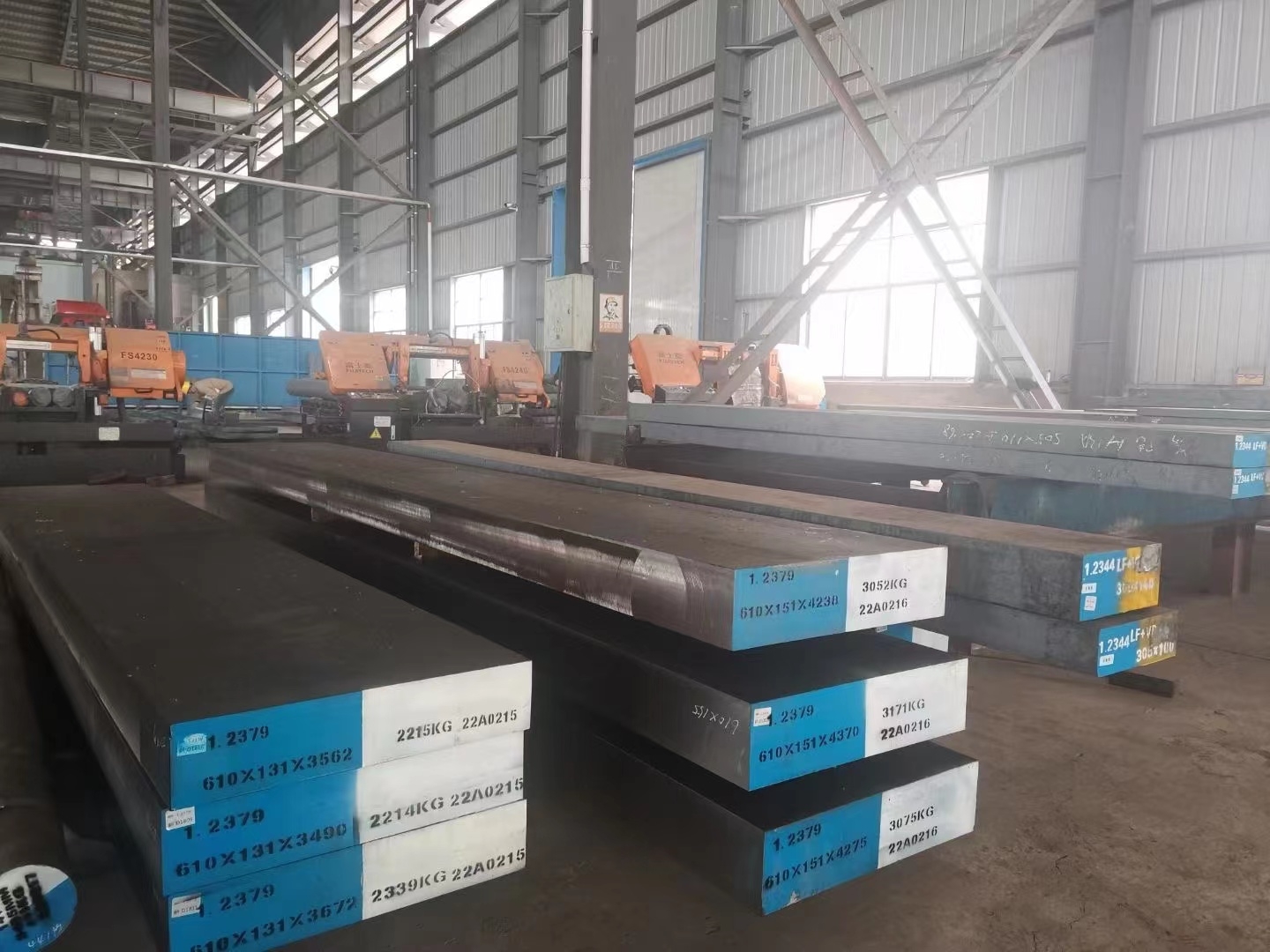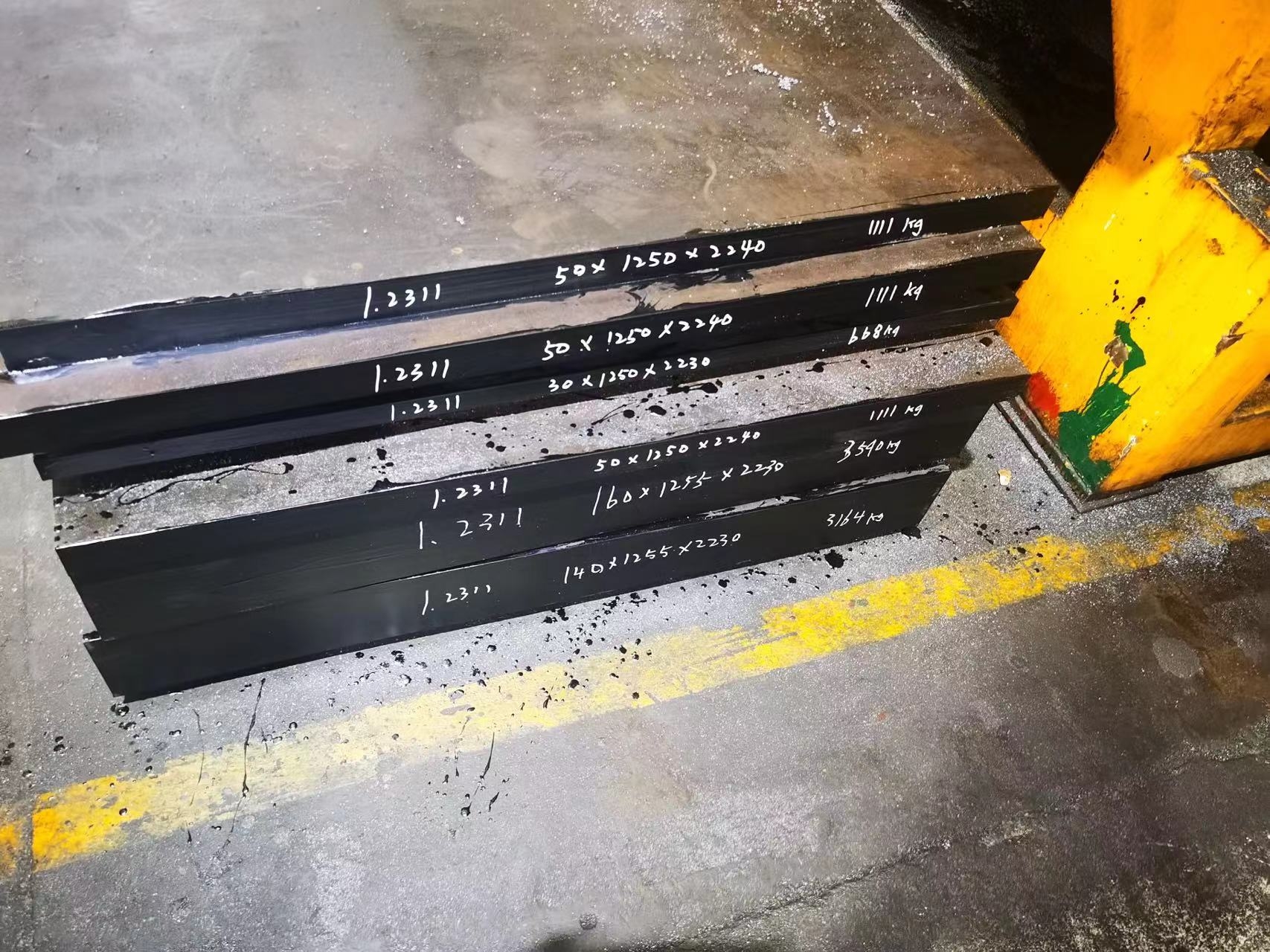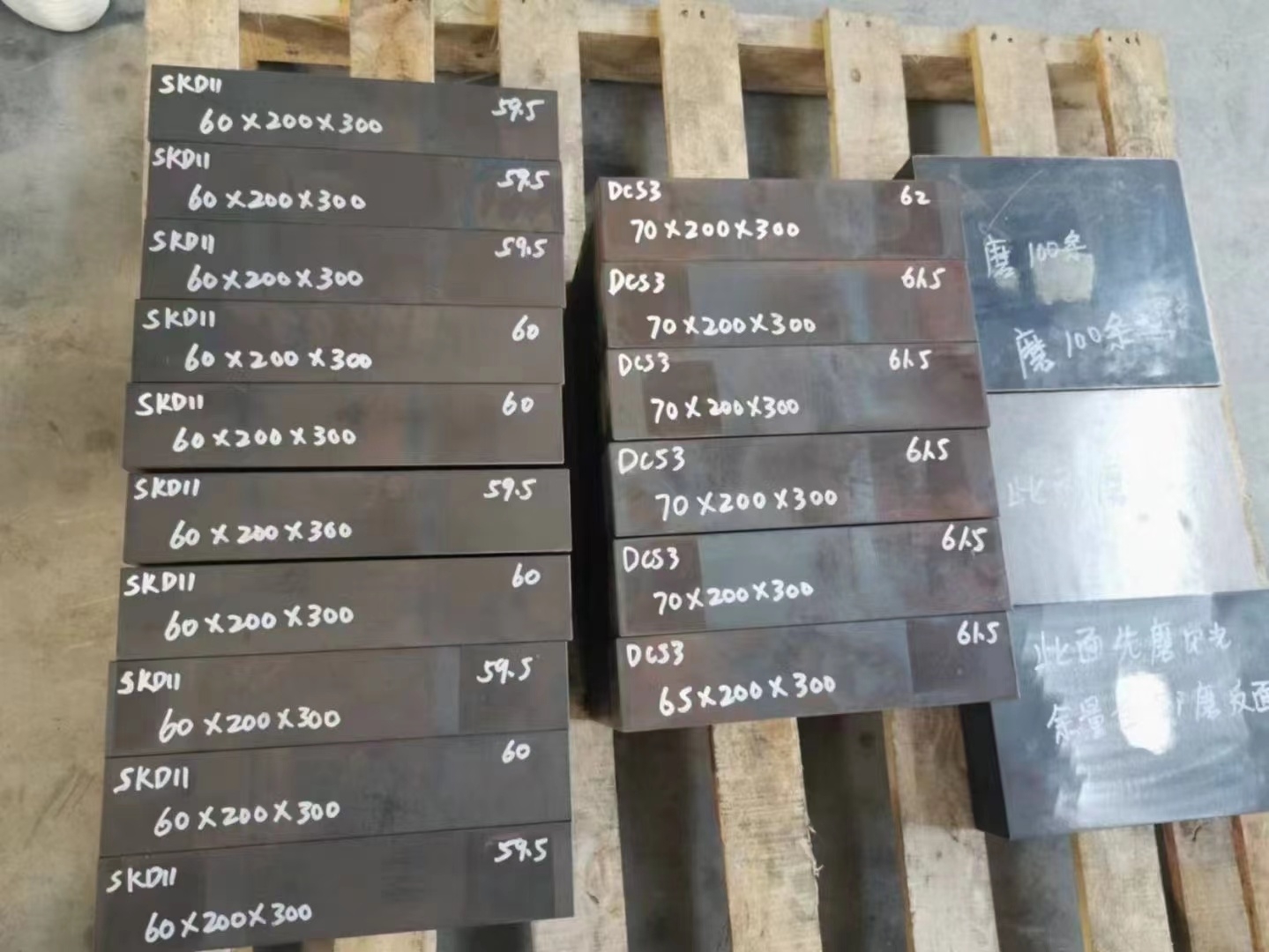AISI H13 DIN 1.2344 SKD61 Hot Work Mould Steel Bar
aisi h13 Hot Work Mould Steel Bars
1 AISI H13 Introduction:
AISI H13 steel is the most popular and most versatile, hot work mould steel, providing a good balance of toughness, heat check resistance, and high temperature strength, in addition to moderate wear resistance. H13 steel can resist softening to 550°C and has good resistance to heat checking. Will Nitride with a case hardness over 1000 V.P.N. Generally supplied annealed to HB 230 max.
2 AISI H13 Applications:
AISI H13 steel is an air hardening, 5% chromium die steel, which is an excellent choice for a wide range of hot work and cold work applications. Typical applications include die casting dies for aluminium, magnesium and zinc, extrusion dies for aluminium and brass, liners, mandrels, pressure pads, followers, bolsters, die cases, die holders and adaptor rings for copper and brass extrusion. H13 steel is used to produce hot stamping and press forge dies, split hot heading dies, gripper dies, hot punching, piercing and trimming tools. Other applications include plastic moulds, shear blades for hot work and hot swaging dies.
3 AISI H13 General Properties:
AISI H13 steel is characterized by
- Good resistance to abrasion at both low and high temperatures.
- High level of toughness and ductility Uniform and high level of machinability and polishability.
- Good high-temperature strength and resistance to thermal fatigue.
- Excellent through-hardening properties.
- Very limited distortion during hardening.
- Good machinability.
- Back to Top
4 AISI H13 Quality Standard:
ASTM A681 Standard Specification for Tool Steel
5 AISI H13 Size:
| Process | Shape | Size |
|---|---|---|
| Hot Rolled | Round | 3.3-130mm |
| Flat | Width(100-1200mm) ; Thickness (12-120mm) | |
| Square | 120-600mm | |
| Hot Forged | Round | 80-1000mm Max Length:15000mm |
| Flat | Width(100-810mm) ; Thickness (30-120mm) | |
| Block | 130-600mmAvailable processes: ESR (less non-metallic inclusions), PESR (less non-metallic and hazardous gas element) Back to Top |
6 AISI H13 All Grades Comparison:
| AS 1239 | ASTM A 681 | BS 4659 | BS EN ISO 4957 | JIS G 4404 | Werkstoff |
|---|---|---|---|---|---|
| H13A | H13/UNS T20813 | BH13 | X40CrMoV 5-1 | SKD 61 | 1.2344/X40CrMoV5-1 Back to Top |
7 AISI H13 Chemical Composition(%):
| Steel Grade | C | Si | Mn | P | S | Cr | Mo | V |
|---|---|---|---|---|---|---|---|---|
| H13 | 0.32-0.45 | 0.90-1.25 | 0.20-0.60 | 0.030 max | 0.030 max | 4.75-5.50 | 1.10-1.75 | 0.80-1.25 |
| DIN1.2344 | 0.35-0.42 | 0.80-1.20 | 0.25-0.50 | 0.030 max | 0.030 max | 4.80-5.50 | 1.20-1.50 | 0.80-1.15 |
| SKD61 | 0.35-0.42 | 0.80-1.20 | 0.25-0.50 | 0.030 max | 0.020 max | 4.80-5.50 | 1.00-1.50 | 0.80-1.15 Back to Top |
8 AISI H13 PESR:
AISI H13 Pressure electroslag remelting process is the metallurgic process for the production of steel with high purity and a controlled solidified and respectively faultless structure under pressures of several atmospheres.
9 AISI H13 Ultrafine Treatment:
AISI H13 steel’s microstructure is effectively refined by the multiple cycle heating and quenching method. The specific process is to heat the steel from room temperature to a temperature slightly above Ac3, hold it for a short time at a lower austenitizing temperature, then quickly quench and cool it to room temperature, and repeat the process. Each cycle heating will obtain more fine austenitic grains.
10 Surface Treatments:
Because of its high tempering temperatures (1000 F), H13 steel may be treated by most surface treating processes, including conventional and ion nitriding, titanium nitriding, and other coatings or treatments. Nitrided surface hardness will be about 60/65 HRC.
H13 material is softer during hot forging, in order to avoid excessive bending, the production length of ordinary forging machines is not more than 9 meters, in the case of Radial forging equipment, the H13 steel forging rounds bar can reach a maximum of 15 meters.
In production, H13 ingots need slowly cooled. After ingot release mould, it need take annealed before being forged.
As delivery for clients, H13 recommends annealing + surface bright( remove the black oxide skin), because the high nickel element is prone to surface cracking.
11 AISI H13 HEAT TREATMENT:
AISI H13 FORGING:
Preheat slowly to 750°C then increase the temperature more rapidly to 1050-1100 °C. Do not forge below 850°C. It is essential to cool the H13 slowly after forging, either in a furnace or in vermiculite.
AISI H13 ANNEALING:
Soak thoroughly at 840-860°C before furnace cooling at a maximum rate of 20°C per hour down to 600°C followed by cooling in air.
AISI H13 STRESS RELIEVING:
When tools made from H13 steel are heavily machined or ground, the relief of internal strains is advisable before hardening to minimise the possibility of distortion. Stress relieving should be done after rough machining. To stress relieve, heat the component carefully to 700°C, allow a good soaking period (two hours per 25mm of ruling section). Cool in the furnace or in air. The tools may then be finish machined before hardening.
AISI H13 HARDENING:
Preheat to 780-820°C. Soak thoroughly, then increase rapidly to the final hardening temperature of 1000-1030°C. When the H13 steel has attained this temperature, soak for approximately thrity minutes. Cool in air. Large sections may be quenched in oil. To reduce scaling or decarburisation, we recommend isothermal molten salt bath treatment. Preheat in salt at 780-820°C then transfer to salt bath standing at 1000-1030°C. Soak and quench into salt standing at 500-550°C. Allow to equalise, withdraw and cool in air. Alternatively, this tool steel may be vacuum hardened or pack hardened. Tools should be tempered as soon as they become hand warm.
QUENCHING MEDIA:
- High speed gas/circulating atmosphere
- Vacuum (high speed gas with sufficient positive pressure). An interrupted quench is recommended where distortion control and quench cracking are a concern
- Martempering bath or fluidized bed at 450–550°C (840–1020°F), then cool in air
- Martempering bath or fluidized bed at approx. 180–220°C (360–430°F) then cool in air
- Warm oil.
Note 1: Temper the tool as soon as its temperature reaches 50–70°C (120–160°F).
Note 2: In order to obtain the optimum properties for the tool, the cooling rate should be fast, but not
at a level that gives excessive distortion or cracks.
TEMPERING:
AISI H13 Heat uniformly to the required temperature allowing a soaking time of two hours per 25mm of ruling section. Withdraw from the furnace and allow to cool in air. A second tempering is strongly recommended, the H13 steel being allowed to cool to room temperature between tempers. The usual tempering range is 530-650°C depending on the hardness requirements and the operating temperature of the tool.
12 Typical Hardness/Applications – Air cooled at 1020°C–1050°C & tempered:
| Temper | HRC | Typical Applications |
|---|---|---|
| 500°C | 53–55 | Swaging dies |
| 550°C | 52-54 | Ejector pins & nozzles for tin, lead or zinc die casting |
| 575°C | 50–52 | Blanking & bending dies. Aluminium die casting dies |
| 600°C | 47–50 | Gripper and header dies |
| 610°C | 46–49 | Forging dies and inserts, extrusion dies, mandrels |
| 620°C | 44–48 | Hot shears, forming dies and punches Back to Top |
13 Welding:
AISI H13 in general, we do not advise the welding of tool steel but users sometimes prefer to weld in order to avoid the cost of retooling. It should be remembered that this grade is an air hardening steel and that in welding the area of the weld attains a temperature of about 1000°C. Cracking is likely to occur during cooling unless proper precautions are taken. Popular methods of welding are atomic hydrogen and argon arc. We recommend you contact your welding consumables supplier who should provide you full assistance and information on welding tool steels.
Welding Procedure
- It is desirable to anneal the tool prior to welding but with care welding may be done on hardened and tempered tools.
- It is important to preheat the die to 300-500°C and to maintain this temperature during welding.
- After the weld has been completed, maintain at 300-500°C for one hour, then cool the die slowly in a furnace or in insulating material.
- If the tool has been annealed prior to welding, stress relieve at 700°C before re-hardening.
- If the tool has not been annealed prior to welding, re-temper at 550-600°C for a minimum of 2 hours.
- Back to Top
14 Final Grinding:
aisi h13 Select the correct grade of wheel in consultation with the grinding wheel manufacturer. Ensure the grinding wheel is in good condition by means of a suitable dressing tool. Wet grinding is a preferable option using a copious supply of coolant. If dry grinding is resorted to then use a very soft wheel.
15 AISI H13 Mill′s test certificate:
EN 10204/3.1 with all relevant data reg. chem. composition, mech. properties and results of testing.




